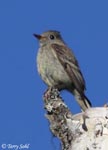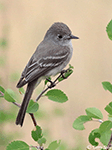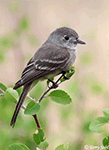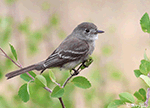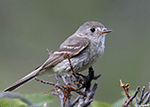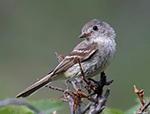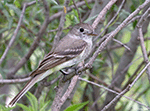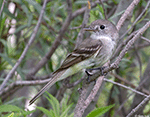| Length: 5.75 inches | Wingspan: 8.5 inches | Seasonality: Summer / Migrant |
| ID Keys: White eye-ring, 2 wing-bars, grayish upperparts with a tinge of green, Difficult to differentiate with Gray and Hammond's Flycatchers. | ||
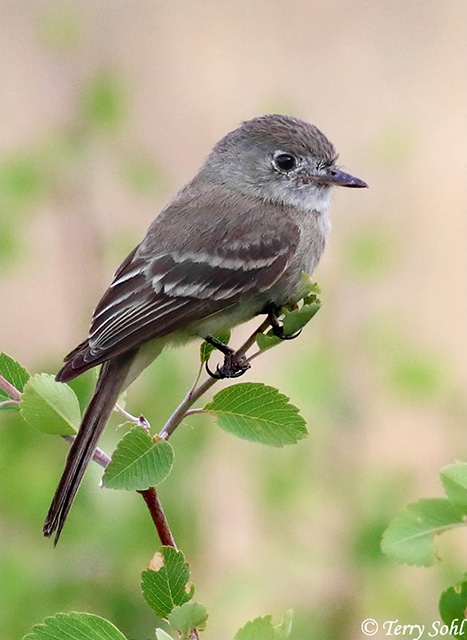 The Dusky Flycatcher is
one of three confusing and similar Empidonax flycatchers found in the western
part of the continent, with the other two being the
Gray and
Hammond's
Flycatchers. The three species are often differentiated from each
other by habitat, as each prefers different elevation zones. The
Dusky Flycatcher is the "middle" species, found at middle elevations in
mountains throughout western North America, with a preference for
shrubby habitats or woodland edges.
The Dusky Flycatcher is
one of three confusing and similar Empidonax flycatchers found in the western
part of the continent, with the other two being the
Gray and
Hammond's
Flycatchers. The three species are often differentiated from each
other by habitat, as each prefers different elevation zones. The
Dusky Flycatcher is the "middle" species, found at middle elevations in
mountains throughout western North America, with a preference for
shrubby habitats or woodland edges.
Habitat:
The preferred summer breeding habitat is a mix of trees and shrubs, and can include open forest with a shrubby understory, mountain chaparral, or brushy slopes with just a few scattered trees. In winter, can be found in riparian areas in Mexico.
Diet:
Feeds almost exclusively on insects.
Behavior:
Forages in typical flycatcher fashion, observing from a perch and flying out to catch passing insects. They will also sometimes hover to glean insects from foliages or twigs.
Nesting:
June and July. The nest of a Dusky Flycatcher is built in the fork of a small tree or in a shrub, sometimes within 2 or 3 feet of the ground, but most typically from 5 to 15 feet up. The nest itself is a small cup built primarily of grasses, with a lining of finer grasses, down, animal hair, and/or moss. The female lays between 2 and 5 eggs, and she alone incubates them. Incubation is about 2 weeks, with the young fledging from the nest about 12-15 days after hatching.
Song:
Variable songs of chirp, greeep, or pweet.
1Click here to hear the song of a Dusky Flycatcher
2Click here to hear the call of a Dusky Flycatcher
Migration:
Summers at middle elevations in the mountains of the western United States and western Canada. Winters in Mexico
Interactive eBird Map:
Click here to access an interactive eBird map of Dusky Flycatcher sightings
Similar Species:
One of the Empidonax flycatchers, and thus...damned hard to differentiate from other Empidonax Flycatchers! Those most likely to be confused with Dusky Flycatcher include the following. Take the notes below with a bit of caution, as it can be extremely difficult to identify these species based on looks alone. Habitat and voice are often better ways to differentiate the species.
- Gray Flycatcher - Generally somewhat paler than a Dusky Flycatcher. Gray Flycatchers are often found in more open habitats with less vegetation than Dusky, which are often found in shrubby areas or woodland edges (such as bird above, found in a shrubby are of moderately high elevation in Mesa Verde National Park in Colorado).
- Hammond's Flycatcher - Habitat is one clue, as Hammond's Flycatchers are often found in evergreen forests, as opposed to the shrubby habitats of Dusky Flycatchers. Apparent tail length is also a clue, as Hammond's Flycatchers appear to have shorter tails than a Dusky Flycatcher. That is partially due to the length of the primary projections on the wings of a Hammond's Flycatcher, which are more pointed and extend further past the secondary wing feathers on a Hammond's Flycatcher, contributing to the appearance of a shorter tail.
Conservation Status:
Numbers are generally stable, but may be declining in some locations. However, they are still found across a relatively broad geographic area, and are common in parts of their range. The IUCN considers the Dusky Flycatcher to be a species of "Least Concern".
Further Information:
1) USGS Patuxent Bird Identification InfoCenter, Dusky Flycatcher
2) WhatBird - Dusky Flycatcher
3) Audubon Guide - Dusky Flycatcher
Photo Information:
June 15th, 2018 - Mesa Verde National Park, Colorado - Terry Sohl
Audio File Credits:
1Ed Pandolfino. Recorded in El Dorado County, California on July 9th, 2018. Original recording and information from xeno-canto.
2Frank Lambert. Recorded in Los Angeles County, California on May 7th, 2015. Original recording and information from xeno-canto.
| Click on the map below for a higher-resolution view |
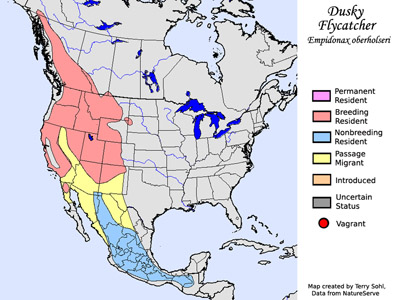 |
| South Dakota Status: Common summer resident in the Black Hills |
Additional Dusky Flycatcher Photos
